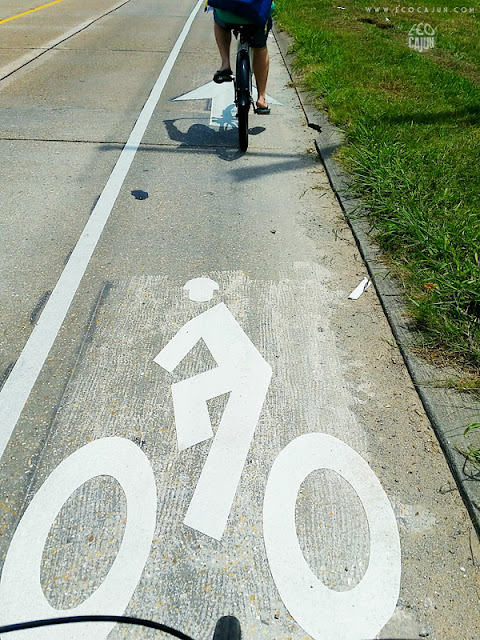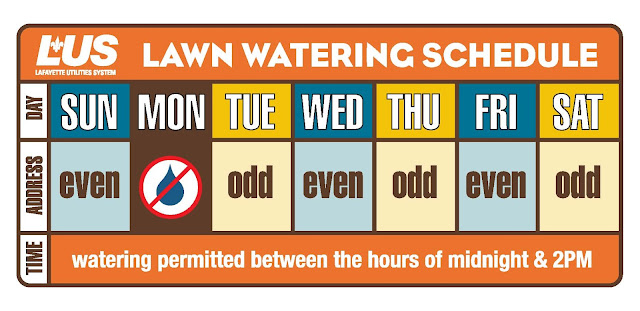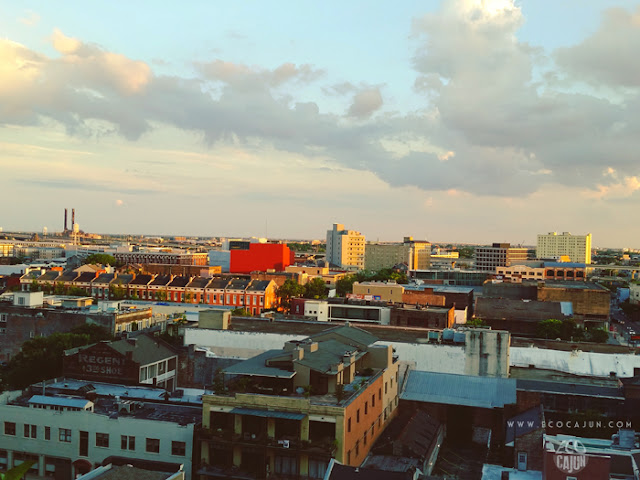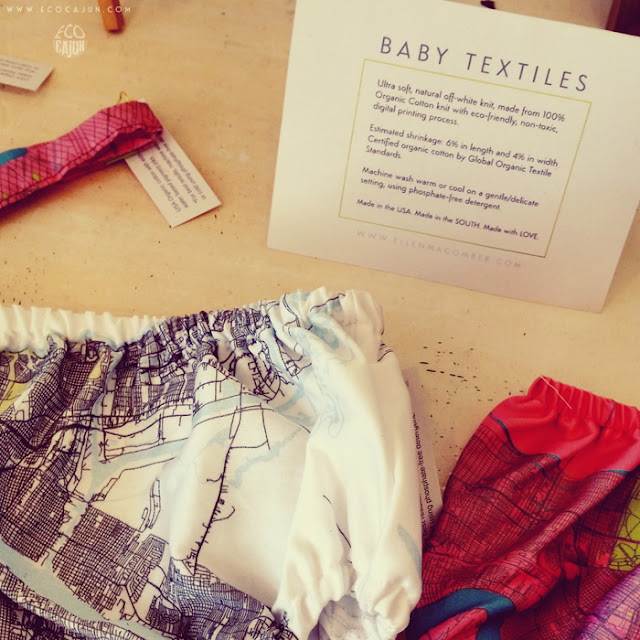During the development of the Lafayette Comprehensive Plan, one of the community elements that stood out time and time again was the inclusion of bike lanes on more city streets. And as the University of Louisiana at Lafayette improves its campus and its location within the city, bike lanes on and around campus have proliferated. The lanes have helped give the heart of Lafayette more accessibility by bike and by foot.
More bicycles on the road can mean fewer cars, and when it comes to major events in town, it alleviates parking issues. Biking to Festival International is a no-brainer to me, and biking to UL Lafayette football games is a perfect way to leave the car at home.
It's been amazing to watch Lafayette progress, even in just the past few years, to become a more bicycle-friendly city. I've been very vocal on the blog on my own love of riding and the benefits riding has for my fiance and me. (Read through all blog posts tagged with 'bikes'!)
We've had our share of scary moments and encounters with rude, obnoxious or distracted drivers. But it hasn't deterred us from riding.
The addition of bike lanes throughout the city has been a welcome one, giving us a greater sense of safety and protection while riding. Many times, we choose to ride on residential roads because the speeds are slower and traffic is lighter. If a residential road has a bike lane? Well, that's pretty much one of the best roads to be on. During National Bike Month last May, I researched and wrote this post on Lafayette's bike lanes, including one that is again receiving attention.
Unfortunately, there has been a petition filed with the Lafayette Consolidated Government to remove the bike lanes that were added to West Bayou Parkway last year.
West Bayou Parkway was scary to ride down before, even though it's residential and the homes are beautiful. It's a connector to larger roads in the city, serving as a great alternate route for bike riders. There aren't sidewalks on a large portion of the road, even though we aren't supposed to ride on them anyway. Because of the proximity to Red's, it's a popular route for joggers and runners, who should be on a sidewalk - except when there is not one. When the bike lanes were added, I cheered with a sigh of relief we would have our own space to ride, instead of worrying about cars speeding around the curves or riding our ass instead of just passing.
There are so many reasons someone may ride a bicycle in and around Lafayette. Athletes ride for competition or sport. So many people, younger and older, ride for exercise, leisure, solitude, or a social activity. Adults commute to work for the 'alone time', gas savings and exercise. Children ride to learn, have fun, visit friends or get to school. College students commute because it's more cost effective.
But most importantly, many people have no other choice. They may not have the money to buy or maintain a vehicle, but still need to get to work or to the store. They may not even have a driver's license. They may not have time to wait for a city bus.
Not everyone enjoys the same luxuries. Just because the majority of Lafayette residents have a car and use them the majority of the time, it doesn't mean there should be no options for bike riders or even pedestrians. Bike lanes provide the same sense of "space" to pedestrians, joggers or runners, especially in areas where there are no sidewalks.
Bicyclists, especially, are not supposed to ride on sidewalks. It's stated in Louisiana statutes that bicycles belong on the road, sharing lanes with cars. Bike lanes simply help that organization, and actually make it easier for cars to travel alongside bikes without having to slow down to pass (three feet!)
Progress does not mean taking out bike lanes that have been installed. Yes, it may not be one of the hardest things to reverse, but it's about much more than another can of paint. The move is a roll backwards. (Not a step, because these people aren't walking; they are driving every single place they need to go.)
Bike lanes benefit a large swath of people in our community, and creating bike paths and lanes in a connected pattern gives our community so many more options.
It's a true sense of sharing the road - something that should be done no matter what, but is done much more visibly with a dedicated bike lane.
Progress is giving all residents of our community an option to safely travel where they need to go, especially if it's on foot or on a bicycle. Bike lanes are one of the best ways to promote safety and encourage alternate transportation.
And follow Forward Lafayette on Facebook.
0
More bicycles on the road can mean fewer cars, and when it comes to major events in town, it alleviates parking issues. Biking to Festival International is a no-brainer to me, and biking to UL Lafayette football games is a perfect way to leave the car at home.
 |
| Enjoying a ride down the newly striped bike lane, heading toward Moncus Park at the Horse Farm, on Bertrand Drive in Lafayette. |
It's been amazing to watch Lafayette progress, even in just the past few years, to become a more bicycle-friendly city. I've been very vocal on the blog on my own love of riding and the benefits riding has for my fiance and me. (Read through all blog posts tagged with 'bikes'!)
We've had our share of scary moments and encounters with rude, obnoxious or distracted drivers. But it hasn't deterred us from riding.
The addition of bike lanes throughout the city has been a welcome one, giving us a greater sense of safety and protection while riding. Many times, we choose to ride on residential roads because the speeds are slower and traffic is lighter. If a residential road has a bike lane? Well, that's pretty much one of the best roads to be on. During National Bike Month last May, I researched and wrote this post on Lafayette's bike lanes, including one that is again receiving attention.
Unfortunately, there has been a petition filed with the Lafayette Consolidated Government to remove the bike lanes that were added to West Bayou Parkway last year.
West Bayou Parkway was scary to ride down before, even though it's residential and the homes are beautiful. It's a connector to larger roads in the city, serving as a great alternate route for bike riders. There aren't sidewalks on a large portion of the road, even though we aren't supposed to ride on them anyway. Because of the proximity to Red's, it's a popular route for joggers and runners, who should be on a sidewalk - except when there is not one. When the bike lanes were added, I cheered with a sigh of relief we would have our own space to ride, instead of worrying about cars speeding around the curves or riding our ass instead of just passing.
There are so many reasons someone may ride a bicycle in and around Lafayette. Athletes ride for competition or sport. So many people, younger and older, ride for exercise, leisure, solitude, or a social activity. Adults commute to work for the 'alone time', gas savings and exercise. Children ride to learn, have fun, visit friends or get to school. College students commute because it's more cost effective.
But most importantly, many people have no other choice. They may not have the money to buy or maintain a vehicle, but still need to get to work or to the store. They may not even have a driver's license. They may not have time to wait for a city bus.
Not everyone enjoys the same luxuries. Just because the majority of Lafayette residents have a car and use them the majority of the time, it doesn't mean there should be no options for bike riders or even pedestrians. Bike lanes provide the same sense of "space" to pedestrians, joggers or runners, especially in areas where there are no sidewalks.
Bicyclists, especially, are not supposed to ride on sidewalks. It's stated in Louisiana statutes that bicycles belong on the road, sharing lanes with cars. Bike lanes simply help that organization, and actually make it easier for cars to travel alongside bikes without having to slow down to pass (three feet!)
Progress does not mean taking out bike lanes that have been installed. Yes, it may not be one of the hardest things to reverse, but it's about much more than another can of paint. The move is a roll backwards. (Not a step, because these people aren't walking; they are driving every single place they need to go.)
Bike lanes benefit a large swath of people in our community, and creating bike paths and lanes in a connected pattern gives our community so many more options.
It's a true sense of sharing the road - something that should be done no matter what, but is done much more visibly with a dedicated bike lane.
Progress is giving all residents of our community an option to safely travel where they need to go, especially if it's on foot or on a bicycle. Bike lanes are one of the best ways to promote safety and encourage alternate transportation.
Please support keeping the bike lanes on West Bayou Parkway by signing the petition started by Forward Lafayette.
And follow Forward Lafayette on Facebook.











![Ways to Recycle Packing Peanuts [ecocajun.com]](https://2.bp.blogspot.com/-fiUgW_MgfzE/V2tW-0n-YoI/AAAAAAAADvI/BYmFOQrXxcoRUcPRHqsakym0xQxRHezmgCLcB/s640/4324937445_6defb66215_b_packing-peanuts-e1427468364380-720x340.jpg)

























